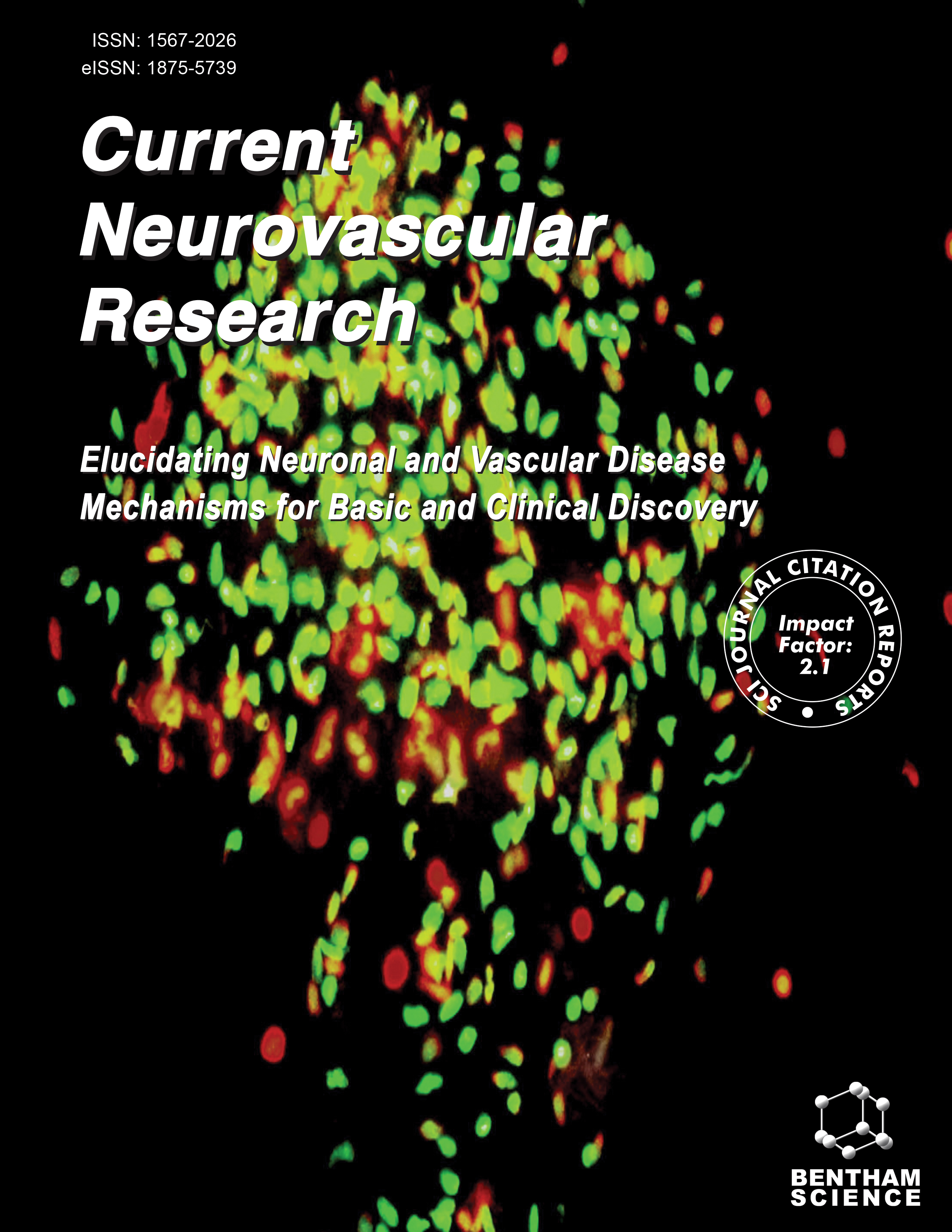- Home
- A-Z Publications
- Current Neurovascular Research
- Previous Issues
- Volume 6, Issue 2, 2009
Current Neurovascular Research - Volume 6, Issue 2, 2009
Volume 6, Issue 2, 2009
-
-
Depressed Glucose Consumption at Reperfusion following Brain Ischemia does not Correlate with Mitochondrial Dysfunction and Development of Infarction: An in vivo Positron Emission Tomography Study
More LessGlucose consumption is severely depressed in the ischemic core, whereas it is maintained or even increased in penumbral regions during ischemia. Conversely, glucose utilization is severely reduced early after reperfusion in spite that glucose and oxygen are available. Experimental studies suggest that glucose hypometabolism might be an early predictor of brain infarction. However, the relationship between early glucose h Read More
-
-
-
Bradykinin is Involved in the Mediation of Cardiac Nociception during Ischemia through Upper Thoracic Spinal Neurons
More LessAuthors: Chao Qin, Jian-qing Du, Jing-shi Tang and Robert D. ForemanBradykinin is one of metabolites produced during myocardial ischemia and infarction that can activate cardiac spinal (sympathetic) sensory neurons to cause chest pain. The aim of this study was 1) to characterize the responses of thoracic superficial and deeper spinal neurons in rats to intrapericardial administration of bradykinin as a noxious cardiac stimulus; 2) to compare neuronal responses to bradykinin alone and a Read More
-
-
-
Neutralization of Interleukin-1β Reduces Vasospasm and Alters Cerebral Blood Vessel Density Following Experimental Subarachnoid Hemorrhage in Rats
More LessSubarachnoid hemorrhage (SAH) develops when extravasated arterial blood enters subarachnoid space and mixes with cerebrospinal fluid. As a result, many pathologies develop, including arterial vasospasm that leads to the ischemia and hypoxia. Immuno-inflammatory response is considered as the cause of numerous complications following SAH. In the study, we examined the role of one of major cytokines, interle Read More
-
-
-
Presynaptic NR2B-Containing NMDA Autoreceptors Mediate Glutamatergic Synaptic Transmission in the Rat Visual Cortex
More LessAuthors: Yan-Hai Li, Jue Wang and Guangjun ZhangN-methyl-D-aspartate (NMDA) receptors (NMDA-Rs) have different modulatory effects on excitatory synaptic transmission depending on the receptor subtypes involved. The present study investigated the subunit composition of the presynaptic NMDA-Rs in layer II/III pyramidal neurons of the rat visual cortex. We recorded evoked a-amino-3-hydroxy- 5-methyl-4-isoxazolepropionic acid (AMPA) receptor-mediated excitatory Read More
-
-
-
Perinatal Asphyxia in Preterm Neonates Leads to Serum Changes in Protein S-100 and Neuron Specific Enolase
More LessIn preterm infants, neurological signs and clinical manifestations of brain damage are limited criteria for diagnosis of neurologic sequelae. Early indicators of brain damage are needed and currently some specific biochemical markers of brain injury are investigated to assess regional brain damage after perinatal asphyxia in neonates. In this study Protein S-100 (PS-100) and Neuron Specific Enolase (NSE) serum levels were Read More
-
-
-
Angelica Injection Improves Functional Recovery and Motoneuron Maintenance with Increased Expression of Brain Derived Neurotrophic Factor and Nerve Growth Factor
More LessAuthors: Qin Cui, Junjian Zhang, Lei Zhang, Ruiling Li and Hui LiuThis study assessed the neuroprotective effects of angelica injection in the rat sciatic nerve crush injury (SCI). Forty eight male Sprague Dawley rats were randomly divided into 4 groups: one was the sham group (S), which received sham surgery and given saline injection and the others were received SCI surgery and given saline injection, high and low dose angelica injection for 4 weeks, respectively. The sciatic functional inde Read More
-
-
-
Neutralizing Endogenous VEGF Following Traumatic Spinal Cord Injury Modulates Microvascular Plasticity but not Tissue Sparing or Functional Recovery
More LessAuthors: Richard L. Benton, Melissa A. Maddie, Mark J. Gruenthal, Theo Hagg and Scott R. WhittemoreAcute loss of spinal cord vascularity followed by an endogenous adaptive angiogenic response with concomitant microvascular dysfunction is a hallmark of traumatic spinal cord injury (SCI). Recently, the potent vasoactive factor vascular endothelial growth factor (VEGF) has received much attention as a putative therapeutic for the treatment of various neurodegenerative disorders, including SCI. Exogenous VEGF exerts bot Read More
-
-
-
Blood Brain Barrier Compromise with Endothelial Inflammation may Lead to Autoimmune Loss of Myelin during Multiple Sclerosis
More LessBy Marian SimkaMultiple sclerosis is an autoimmune disease characterized by multifocal areas of inflammation and demyelination within the central nervous system. The mechanism that triggers the disease remains elusive. However, recent findings may indicate that multiple sclerosis, at its source, could be a hemodynamic disorder. It has been found that multiple sclerosis patients exhibit significant stenoses in extracranial veins draining t Read More
-
Volumes & issues
-
Volume 21 (2024)
-
Volume 20 (2023)
-
Volume 19 (2022)
-
Volume 18 (2021)
-
Volume 17 (2020)
-
Volume 16 (2019)
-
Volume 15 (2018)
-
Volume 14 (2017)
-
Volume 13 (2016)
-
Volume 12 (2015)
-
Volume 11 (2014)
-
Volume 10 (2013)
-
Volume 9 (2012)
-
Volume 8 (2011)
-
Volume 7 (2010)
-
Volume 6 (2009)
-
Volume 5 (2008)
-
Volume 4 (2007)
-
Volume 3 (2006)
-
Volume 2 (2005)
-
Volume 1 (2004)
Most Read This Month
Article
content/journals/cnr
Journal
10
5
false
en


